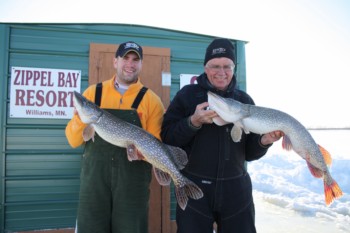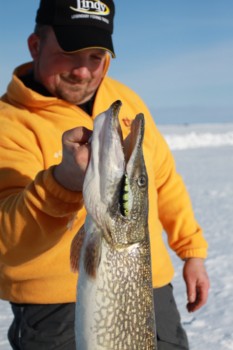Tail End Pike
Category: article
Mar 14th, 2011 by OutdoorsFIRST
Modified Mar 14th, 2011 at 12:00 AM
Lake of the Woods is known as a walleye factory, and it is that. ‘Eyes abound in all sizes, and all year long.
But what isn’t quite so well known is that Lake of the Woods is also a pretty darn good spot to catch a pike, and if the truth were to be known, then Zippel Bay is one of the better places to pike it up, especially at the tail end of the ice season.
 |
|
The reason for that is two-fold. First, Zippel Bay offers good spawning territory for pike and the forage fish upon which they feed. Second, Zippel Bay Resort is located on the bay and offers a full range of fishing opportunities for pike, all year long. So, it’s hard to find a better place to stage a trip for pike late in the ice season.
Then the resort itself is a draw; it offers all you’d expect from a Minnesota resort, and it is dedicated to serving its fishermen clients. If you need something for fishing, whether it’s bait or a warm sandwich, Zippel Bay Resort has it.
Not only does the resort offer lodging, a bar, and plowed roads, but it also has bait, a shuttle service and several different kinds of houses, including dark houses for those who still like to spear pike.
“Pike fishing gets really good as soon as the sun starts to warm things up, ” says Zippel Bay Resort owner Nick Painovich. “Usually in late February is when the larger pike start to move into the bay.
As a general rule of thumb, northerns move shallow as spring advances, and it’s nothing at all to catch big pike in three or four or five feet of water.
“I think there is some kind of bug hatch that draws the baitfish in, and following them come the pike. I don’t know for sure that that is the case, but it makes sense. No matter, starting in late February or so, the bigger pike start to move into the bay. It gets really good about he middle of March.
“And if the ice is clear of snow, then it really heats up the action. That really turns things on.”
Painovich says that the pre-spring movement doesn’t require warm weather or snow-free ice; it happens every year, but increasing temps and better solar penetration accelerate the movement.
“You’ll see times when you’re laying a deadbait right on the bottom in two feet of water,” he says, “of course, you’re standing on three feet of ice. Still, you’ll get big pike moving in really shallow when it warms up.”
“Earlier, though, we’ll catch big pike in deeper water,” Painovich adds. “Guys out in our houses (outside the bay) will put tip-ups out, baited with big golden shiner or sucker minnows, and they’ll catch northerns in some of the deeper stuff. That usually happens in the latter part of February.”
Painovich says that Zippel Bay is where you catch smaller pike most of the year-those that fall below the 30-inch slot size. “Bigger pike generally stay outside the bay until the spring movement,” he says.
 |
|
Finding the best areas for pike at any given time is easy: ask Nick or Deanna or any of the staff at the resort. They’ll know the scoop and are willing to share.
But there are no real secrets to their location. Bigger fish are found in the main lake basin, but they’ll move in to Zippel Bay as spring approaches. Smaller pike are found in the bay throughout the year, but you won’t find many outside the bay.
Painovich notes that there are two other locations where you’re likely to find northerns. Bigger fish will run along the sandbars that are found off the mouth of the bay and elsewhere, and a set of tip-ups will intercept these fish when they’re roaming. “You’ll see some big pike running along the sandbars,” he says, “they’re 10, 12, 15 pounds.”
Another situation Painovich highlights is the reefs that have sharp drops. “Zippel Reef, off the mouth of the bay, will hold pike along the edges where it drops off sharply. Look for the shallow edges that drop quickly into 20 feet of water. It’s a good place to jig because you’ve got a limiting area, and the northerns will stack up at times.”
The Igloo is placed on such a reef, so it’s a good landmark. The Igloo is Zippel Bay Resort’s bar-on-the-ice that provides refreshments, sandwiches, catered food, television, holes in the floor for fishing at your table, and the convivial atmosphere that goes along with a group of ice fishermen.
It’s another service that the resort offers. As to the name, well, you only have to see it to know why it’s called that. The resemblance to the iconic icehouses is close enough.
The reef the Igloo is located on, as noted earlier, is an excellent place to try jigging for northerns.
Standard jig-and-minnows do well for use in jigging, but you can also try artificials. Lindy’s big Darter is a natural in any jigging situation as are the larger Viking spoons. The largest Slick Jig should do well, also, when tipped with either a flashy soft plastic or minnow.
Most of the time, noted Painovich, jigging is a waiting game. For best results, tip-ups and live bait are the most popular and most successful technique. “Big golden shiners work well,” Painovich says. “But big sucker minnows are good also. Dead bait is okay, especially after ice out, but it works best in places where you find hard bottom and can lay the bait on the sand or gravel.
In Zippel Bay, the hard bottom areas are at the mouth of the bay where it necks down, and the current sweeps the bottom clear. That’s also a good place to intercept northerns as they move into the bay.
Once March starts winding down, the resort starts winding down as well. While it maintains the roads on the ice, the third week of the month Zippel Bay Resort starts pulling its houses off to beat the April 1 deadline. “The bay warms up fast,” says Painovich. “Toward the end of the season access is by four-wheelers only.
“We try to stay open until the end of March,” he adds . “Then we close and stay closed for two , maybe two-and-a-half weeks.
“Ice usually leaves April 15th or 20th, and traditionally, we have an open-water pike tournament here the last weekend of April,” says Painovich.
While the early, ice-out fishery is good, the fish have finished spawning and are on the skinny side, Painovich notes. If you want big, heavy northerns, you can catch them at the tail end of the ice season.